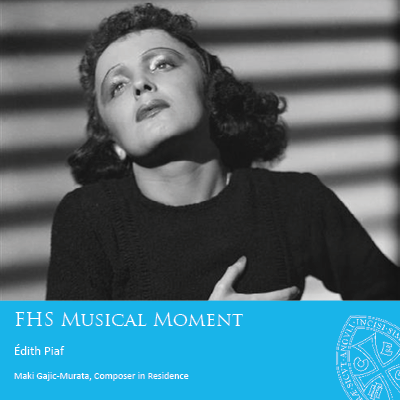Édith Piaf, also known as ‘The Little Sparrow’, rose to international stardom in the late 1930s as a symbol of French passion and tenacity. Of Piaf’s many ballad, ‘La Vie en Rose’, which she wrote, is remembered as her signature song. Other favourites among the singer’s repertoire include ‘Milord’, ‘Padam Padam’, ‘Mon Dieu’, the charming ‘Mon Manège à Moi’ and the anthemic ‘Non, Je Ne Regrette Rien’. Having a life beset by addictions and related health issues, Piaf died in France in 1963 at the age of 47. She continues to be revered as a national treasure.
Édith’s Piaf’s past and early life is shrouded in mystery and may have been dramatised and embellished during her time as a celebrity. Her mother, Annetta Giovanna Maillard, was a café singer and her father was a highly skilled street acrobat. Annetta had abandoned Piaf to live with her maternal grandmother, where grew malnourished. Being taken from that household, Piaf then lived with her paternal grandmother, who ran a brothel. Piaf severed any connection with her father and her immediate family, who were temperamental and often abusive. At 17, she and a youngster named Louis Dupont had a daughter, Marcelle, and much like her own mother, Piaf found herself unable to be a mother and abandoned Marcelle with Louis. Marcelle died from meningitis at two years old.
In 1935, Piaf was ‘discovered’ as a singer and her nervous energy and small stature inspired the name: La Môme Piaf (The Little Sparrow). Continuing the tradition of performing chansons réalistes, she commissioned songs that romanticised her life on the streets, passionately emphasising her inner strength and resilience.
Piaf was one of the most popular performers during the German occupation of France in World War II. Piaf was deemed to have been a traitor and collaborator, although it was later believed that she had been working for the French Resistance and helped Jewish comrades escape Nazi persecution.
After the war, Piaf’s fame spread and she toured Europe, South America and the U.S. Although American audiences were initially put off by her dour demeanor and dark clothes, Piaf garnered glowing reviews.
Piaf was involved in three serious car crashes after 1951, leading to morphine and alcohol addictions. In April 1963, Piaf recorded her last song. With an array of health hardships over the years, Piaf died from liver failure at the age of 47. The archbishop of Paris denied requests for a Mass, citing Piaf’s irreligious lifestyle, but her funeral procession was nonetheless a massive undertaking attended by thousands of devotees. She is buried in Père Lachaise Cemetery in Paris next to her daughter Marcelle.
Édith Piaf’s life was filled with adversity and hardship, but despite her rough start in life, she managed to make a life for herself, and her songs remain iconic and are still sung by many musicians today. Piaf’s songs about resilience and adversity continue to touch the hearts of listeners around the world and her relatable lyrics and soulful voice, I think, guarantees that Piaf’s music will played for generations to come.
Maki Gajic-Murata, Composer-in-Residence














